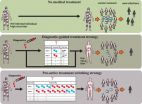(Press-News.org) HOUSTON - (April 30, 2015) - With the Millennium Development Goals established by the United Nations in 2000 coming to an end in 2015, and the new Sustainable Development Goals now in the works to establish a set of targets for the future of international development, experts at Baylor College of Medicine have developed a new tool to show why neglected tropical diseases, the most common infections of the world's poor, should be an essential component of these goals.
Using World Health Organization data for the number people at risk of parasitic worm infections in each of the largest nations and comparing this number to each nation's population, Dr. Peter Hotez, dean of the National School of Tropical Medicine at Baylor College of Medicine, and Dr. Jennifer R. Herricks, postdoctoral fellow at Baylor, developed the worm index, which they found to have a strong association with a nation's human development index, a summary measure of average achievement in key dimensions of human development.
Their work was published today in PLOS Neglected Tropical Diseases.
"Through this paper, we've shown how the major neglected tropical diseases, which include intestinal worm infections, schistosomiasis and lymphatic filariasis, are intimately tied to human development," said Hotez, who also is Texas Children's Hospital Endowed Chair of Tropical Pediatrics and president of the Sabin Vaccine Institute.
"We found a very tight association between the worm index of a country and the human development index. The higher the worm index, the lower the human development index."
Parasitic worm infections affect millions of people and can cause long-term, chronic and disabling diseases.
"Because decreased human development is related to increased burden of parasitic worm infections, we recommend that serious consideration should be given to parasitic worm infections and other neglected tropical diseases when trying to attain goals that will ultimately improve human development; for example, when implementing the sustainable development goals," said Herricks, postdoctoral fellow in Disease and Poverty at the National School of Tropical Medicine at Baylor, who is also with Rice University's James A. Baker III Institute for Public Policy.
INFORMATION:
Please contact plosntds@plos.org if you would like more information about our content and specific topics of interest.
All works published in PLOS Neglected Tropical Diseases are open access, which means that everything is immediately and freely available. Use this URL in your coverage to provide readers access to the paper upon publication:
http://dx.plos.org/10.1371/journal.pntd.0003618 (Link goes live upon article publication)
Contact: Dipali Pathak, 713-798-4710, pathak@bcm.edu, http://www.bcm.edu/news
Authors and Affiliations: Peter J. Hotez1,2,3,4*, Jennifer R. Herricks1,3
1. Department of Pediatrics and Molecular Virology and Microbiology, National School of Tropical Medicine,
Baylor College of Medicine, Houston, Texas, United States of America, 2. Sabin Vaccine Institute and Texas
Children's Hospital Center for Vaccine Development, Houston, Texas, United States of America, 3. James A.
Baker III Institute for Public Policy, Rice University, Houston, Texas, United States of America, 4. Department
of Biology, Baylor University, Waco, Texas, United States of America
* hotez@bcm.edu
About PLOS Neglected Tropical Diseases
PLOS Neglected Tropical Diseases is a peer-reviewed, open-access journal devoted to the pathology, epidemiology, prevention, treatment, and control of the neglected tropical diseases, as well as public policy relevant to this group of diseases. All works published in PLOS Neglected Tropical Diseases are open access, which means that everything is immediately and freely available subject only to the condition that the original authorship and source are properly attributed. The Public Library of Science uses the Creative Commons Attribution License, and copyright is retained by the authors.
About the Public Library of Science
The Public Library of Science (PLOS) is a non-profit organization of scientists and physicians committed to making the world's scientific and medical literature a freely available public resource. For more information, visit http://www.plos.org.
Media Permissions
PLOS Journals publish under a Creative Commons Attribution License, which permits free reuse of all materials published with the article, so long as the work is cited (e.g., Kaltenbach LS et al. (2007) Huntington Interacting Proteins Are Genetic Modifiers of Neurodegeneration. PLOS Genet 3(5): e82. doi:10.1371/journal.pgen.0030082). No prior permission is required from the authors or publisher. For queries about the license, please contact the relative journal contact indicated here: http://www.plos.org/journals/embargopolicy.php
A detailed study of marine animals that died out over the past 23 million years can help identify which animals and ocean ecosystems may be most at risk of extinction today, according to an international team of paleontologists and ecologists.
In a paper to be published in the May 1 issue of the journal Science, researchers from the University of California, Berkeley, and other institutions report that worldwide patterns of extinction remained remarkably similar over this period, with the same groups of animals showing similar rates of extinction throughout and with a ...
Demand for seafood from wild fisheries and aquaculture around the world has nearly doubled over the past four decades. In the past several years, major retailers in developed countries have committed to source their seafood from only sustainably certified fisheries and aquaculture, even though it is not clear where that supply will come from.
A team of researchers led by the University of California, Davis, has focused its attention on fishery improvement projects, or FIPs, which are designed to bring seafood from wild fisheries to the certified market, with only a promise ...
HIV-1 continues to spread globally. While neither a cure, nor an effective vaccine are available, recent focus has been put on 'treatment-for-prevention', which is a method by which treatment is used to reduce the contagiousness of an infected person. A study published this week in PLOS Computational Biology challenges current treatment paradigms in the context of 'treatment for prevention' against HIV-1.
Sulav Duwal, Max von Kleist and their collaborators develop and employ optimal control theory to compute and assess diagnostic-guided vs. pro-active treatment strategies ...
Proteins inside a cell are in constant motion, changing shape continuously in order to carry out their functions. In addition, their multiple component atoms each have individual patterns of motion, making the entire protein a system of non-stop highly complex movement. Understanding how a protein moves is the key to developing drugs that can efficiently interact with it. But because of this complexity, protein motion has been notoriously difficult to study. Scientists at EPFL, IBS-Grenoble, and ENS-Lyon, have developed a new method for studying protein motion by first ...
The fossil record helps to predict which kinds of animals are more likely to go extinct. When combined with information about hotspots of human impacts and climate-change predictions, Smithsonian scientists and colleagues pinpoint animal groups and geographic areas of highest concern for marine conservation in the May 1 issue of Science magazine.
"Just as some groups of people are more prone to health problems like diabetes or heart disease, we can tell from the fossil record which groups of animals are naturally more likely to go extinct," said Aaron O'Dea, paleontologist ...
If you thought that a beetle with a machine gun built into its rear end was something that only exists in sci-fi movies, you should talk to Wendy Moore at the University of Arizona.
Many beetles secrete foul-smelling or bad-tasting chemicals from their abdomens to ward off predators, but bombardier beetles take it a step further. When threatened, they combine chemicals in an explosive chemical reaction chamber in their abdomen to simultaneously synthesize, heat and propel their defensive load as a boiling hot spray, complete with "gun smoke." They can even precisely ...
SEATTLE, Wash. -- More than 1000 dams have been removed across the United States because of safety concerns, sediment buildup, inefficiency or having otherwise outlived usefulness. A paper published today in Science finds that rivers are resilient and respond relatively quickly after a dam is removed.
"The apparent success of dam removal as a means of river restoration is reflected in the increasing number of dams coming down, more than 1,000 in the last 40 years," said lead author of the study Jim O'Connor, geologist with the U.S. Geological Survey. "Rivers quickly erode ...
CAMBRIDGE, Mass--Bombardier beetles, which exist on every continent except Antarctica, have a pretty easy life. Virtually no other animals prey on them, because of one particularly effective defense mechanism: When disturbed or attacked, the beetles produce an internal chemical explosion in their abdomen and then expel a jet of boiling, irritating liquid toward their attackers.
Researchers had been baffled by the half-inch beetles' ability to produce this noxious spray while avoiding any physical damage. But now that conundrum has been solved, thanks to research by a ...
The vivid pigmentation of zebras, the massive jaws of sharks, the fight or flight instinct and the diverse beaks of Darwin's finches. These and other remarkable features of the world's vertebrates stem from a small group of powerful cells, called neural crest cells, but little is known about their origin.
Now Northwestern University scientists propose a new model for how neural crest cells, and thus vertebrates, arose more than 500 million years ago.
The researchers report that, unlike other early embryonic cells that have their potential progressively restricted as ...
ORANGE, Calif. - Researchers in Chapman University's Argyros School of Business and Economics and their collaborators have just published a study on the evolution of yoga in the marketplace. Assistant Professor Gokcen Coskuner-Balli, Ph.D., co-authored the study, which examined how the meaning of yoga transformed in the past three decades. The results show that yoga became decreasingly associated with spirituality and increasingly associated with medicine and fitness. The study argues that the shift in the meanings are due to the changes in how yoga gurus are trained, market ...



